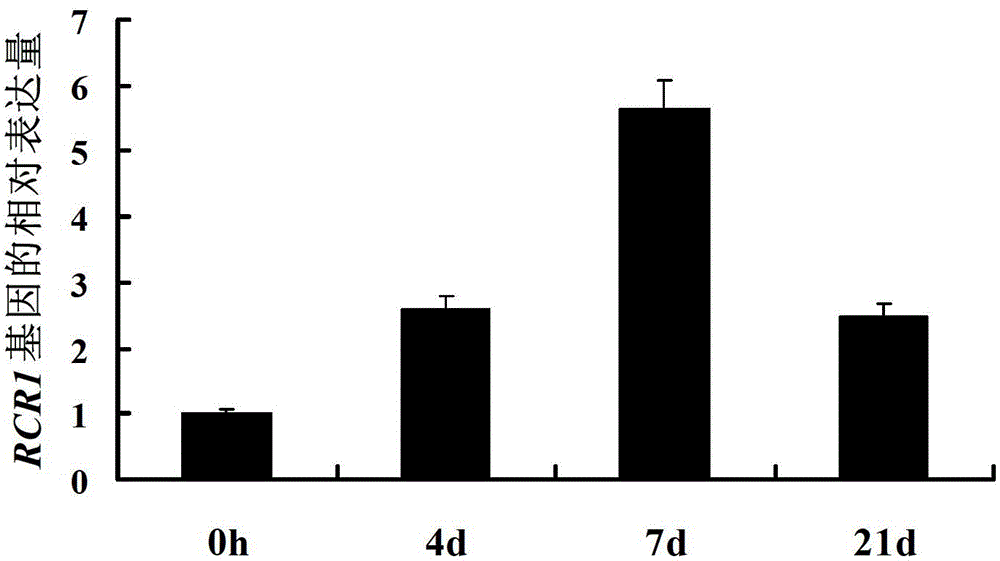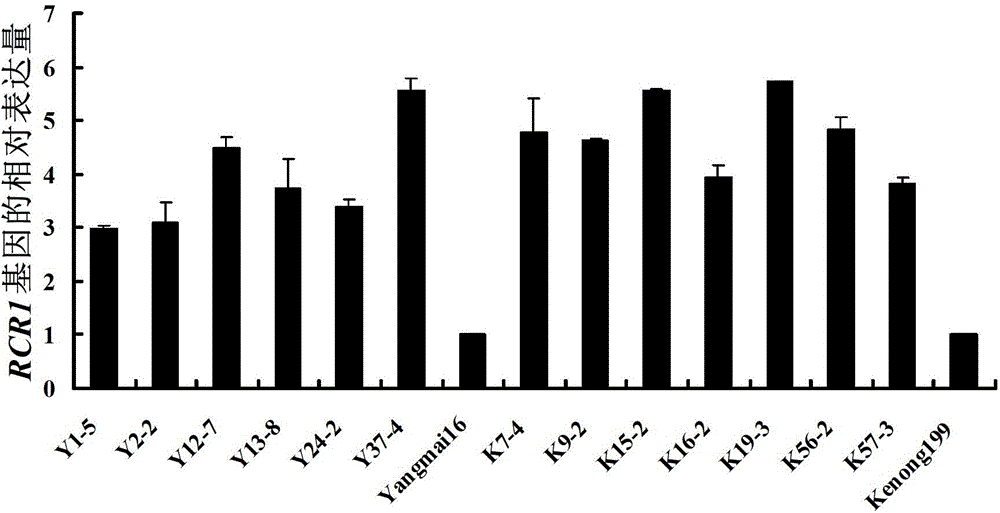Disease resistance-related protein RCR1 derived from wheat, related biomaterials thereof, and application for same
A disease resistance, protein technology, applied in the application, biochemical equipment and methods, introduction of foreign genetic material using vectors, etc., can solve problems such as slow progress in research on root rot resistant wheat varieties
- Summary
- Abstract
- Description
- Claims
- Application Information
AI Technical Summary
Problems solved by technology
Method used
Image
Examples
Embodiment 1
[0078] Embodiment 1, the cloning of wheat resistance protein RCR1 and its coding gene
[0079] The inventors of the present invention analyzed the gene differential expression data of the sheath blight-resistant wheat CI12633 and the sheath blight-susceptible wheat Wenmai 6 by RNA-Sequencing, combined with expression correlation analysis, isolated and cloned the wheat resistant The important gene of sheath blight-RCR1 gene. The specific cloning method is as follows:
[0080] The total RNA of wheat CI12633 leaf sheath was extracted, and the extracted RNA sample was reverse-transcribed to synthesize the first-strand cDNA according to the procedure of the first-strand cDNA synthesis kit of Invitrogen Company, which was used as a template for gene cloning, with U:5'-CCCAGTCAAAGTCCGTCAGT-3 ' and L: 5'-GTGGCTTACAGGCACGCAG-3' as primers for PCR amplification. The amplification program was as follows: pre-denaturation at 94°C for 3 minutes; then 35 cycles at 94°C for 45 seconds, 60°...
Embodiment 2
[0090] Example 2, the acquisition of sheath blight resistant transgenic wheat and the identification of disease resistance
[0091] 1. Construction of recombinant expression vector
[0092] Using the Fast PCR Clone Kit, the complete ORF sequence of the RCR1 gene was constructed on the high-efficiency expression vector pAHC25 of monocotyledonous plants. The specific steps are as follows:
[0093] 1. Preparation of linearized plasmid: Digest the pAHC25 vector plasmid with SmaI and SacI, electrophoresis on 1% agarose gel, and recover the linearized pAHC25 vector framework with an agarose gel DNA purification and recovery kit.
[0094] 2. PCR amplification of the target gene RCR1: design a pair of primers RCR1-O-F according to the ORF sequence of the RCR1 gene: 5'- AACTCGGTATCTAGA ATGGAGTTGGCAGTAGGTGC-3'
[0095] and RCR1-O-R: 5'- CGATCGGGGAAATTC TCAGCTGCTGATAACATGAT-3', the 5' end of the primer introduces a 15 bp sequence complementary to the sequences at both ends of the li...
Embodiment 3
[0145] Embodiment 3, cultivate the transgenic wheat that sheath blight property reduces
[0146] 1. Silencing the RCR1 gene in wheat CI12633 using virus-mediated gene silencing technology
[0147] 1. The two ends of the DNA fragment shown in the 2716-3030 nucleotides of sequence 1 in the sequence listing (sequence 3 in the sequence listing) are respectively provided with NheI recognition sequences. After NheI digestion, insert the DNA fragment (315bp) shown in the 2716-3030th nucleotide of Sequence 1 in the sequence table into the BSMV-γ (γ vector of BMSV virus) linearized by NheI enzyme by reverse insertion method ), the DNA molecule (antiRCR1) that is reverse complementary to the DNA fragment shown in the 2716-3030th nucleotide of Sequence 1 in the sequence listing is driven by the T7 promoter of the γ vector to obtain the recombinant vector BSMV-γ: antiRCR1 .
[0148] 2. At the two-leaf one-heart stage, use the recombinant vector BSMV-γ:antiRCR1 to transfect the second le...
PUM
 Login to View More
Login to View More Abstract
Description
Claims
Application Information
 Login to View More
Login to View More - R&D
- Intellectual Property
- Life Sciences
- Materials
- Tech Scout
- Unparalleled Data Quality
- Higher Quality Content
- 60% Fewer Hallucinations
Browse by: Latest US Patents, China's latest patents, Technical Efficacy Thesaurus, Application Domain, Technology Topic, Popular Technical Reports.
© 2025 PatSnap. All rights reserved.Legal|Privacy policy|Modern Slavery Act Transparency Statement|Sitemap|About US| Contact US: help@patsnap.com



